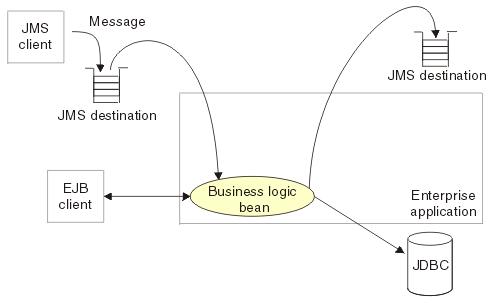JMS interfaces - explicit polling for messages
This topic provides an overview of applications that use JMS interfaces to explicitly poll for messages on a destination then retrieve messages for processing by business logic beans (enterprise beans).
WAS supports asynchronous messaging as a method of communication based on the JMS programming interfaces. JMS provides a common way for Java programs (clients and J2EE applications) to create, send, receive, and read asynchronous requests, as JMS messages.
The base support for asynchronous messaging using JMS, shown in the following figure, provides the common set of JMS interfaces and associated semantics that define how a JMS client can access the facilities of a JMS provider. This enables WebSphere J2EE applications, as JMS clients, to exchange messages asynchronously with other JMS clients by using JMS destinations (queues or topics).
Applications can use both point-to-point and publish/subscribe messaging (referred to as "messaging domains" in the JMS specification), while supporting the different semantics of each domain.
WAS supports applications that use JMS 1.1 domain-independent interfaces (referred to as the "common interfaces" in the JMS specification). With JMS 1.1, the preferred approach for implementing applications is to use the common interfaces. The JMS 1.1 common interfaces provide a simpler programming model than domain-specific interfaces. Also, applications can create both queues and topics in the same session and coordinate their use in the same transaction.
The common interfaces are also parents of domain-specific interfaces. These domain-specific interfaces (provided for JMS 1.0.2 in WebSphere Application Server V5) are supported only to provide inter-operation and backward compatibility with applications that have already been implemented to use those interfaces.
A WebSphere application can use the JMS interfaces to explicitly poll a JMS destination to retrieve an incoming message, then pass the message to a business logic bean. The business logic bean uses standard JMS calls to process the message; for example, to extract data or to send the message on to another JMS destination. Figure 1. Asynchronous messaging using JMS. This figure shows an enterprise application polling a JMS destination to retrieve an incoming message, which it processes with a business logic bean. The business logic bean uses standard JMS calls to process the message; for example, to extract data or to send the message on to another JMS destination. For more information, see the text that accompanies this figure.

WebSphere applications can use standard JMS calls to process messages, including any responses or outbound messaging. Responses can be handled by an enterprise bean acting as a sender bean, or handled in the enterprise bean that receives the incoming messages. Optionally, this process can use two-phase commit within the scope of a transaction. This level of functionality for asynchronous messaging is called bean-managed messaging, and gives an enterprise bean complete control over the messaging infrastructure; for example, for connection and session pool management. The appserver has no role in bean-managed messaging.
WebSphere applications can also use message-driven beans, as described in related topics.
For more details about JMS, see Sun's JMS (JMS) specification documentation.
Related concepts
Message-driven beans - automatic message retrieval
Related Reference
JMS interfaces